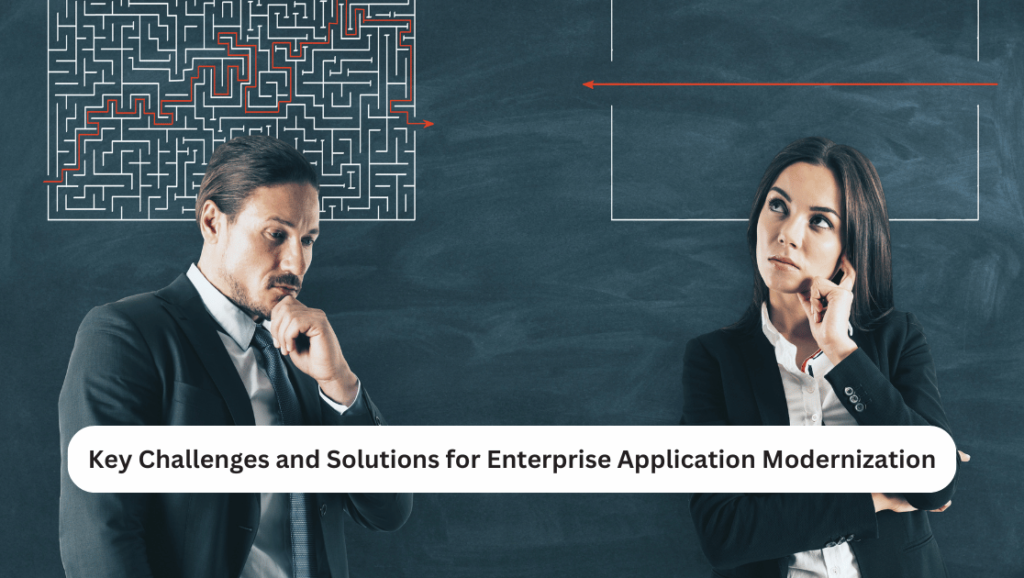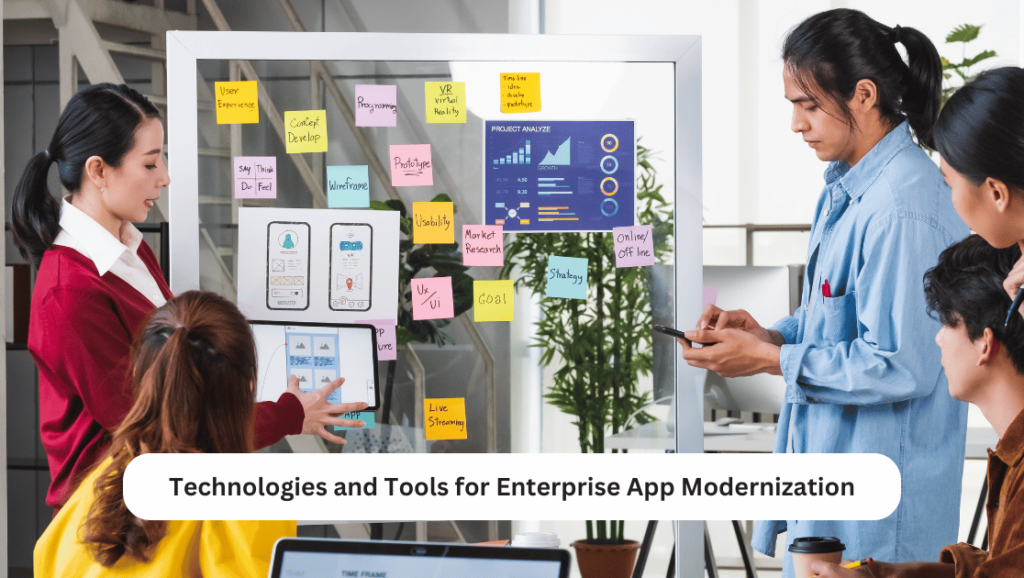Enterprise App Modernization: 2025 Guide to Transformation
Gaurav Singh Rawat
- April 9, 2025
- 12 Min Read

Enterprise Application Modernization is the process of updating an organization’s legacy software applications to take advantage of newer computing approaches, frameworks, languages and infrastructure platforms. In today’s rapidly evolving digital landscape, modernizing legacy applications has become a top priority for businesses looking to stay competitive, agile and innovative.
Application modernization involves more than just lifting and shifting old software to the cloud. It is a holistic approach that addresses the shortcomings of monolithic, outdated applications in terms of scalability, performance, user experience and alignment with current business needs.
By breaking down legacy applications into microservices architectures, refactoring code, integrating APIs and leveraging cloud-native technologies, enterprises can breathe new life into their software portfolio.
What does modernization mean?
Modernization is the process of updating organizational processes, systems, and tools to the most current versions or best practices. In the context of enterprise applications, modernization involves transitioning legacy software to newer computing approaches, including modern languages, frameworks, and cloud infrastructure platforms.
The goal of application modernization is to improve an application’s performance, scalability, security and alignment with current business needs, rather than completely replacing it. This extends the lifespan of an organization’s software investments while taking advantage of technological advancements

Future-Proof Your Business
Modernize your enterprise apps to stay competitive. Leverage the latest technologies for innovation and growth.
Benefits of Application Modernization
Application modernization delivers a multitude of benefits – from enhancing performance, security and user experiences to enabling greater agility, cost savings and innovation.
It empowers businesses to optimize their existing investments while transforming to meet current and future demands in an increasingly competitive digital world. Here are the key benefits of application modernization:
Improved scalability and performance
Modernizing applications enhances their ability to handle increased workloads efficiently. It optimizes code, improves system architecture, and leverages the latest technologies to significantly boost application performance and scalability to accommodate business growth.
Enhanced security and reduced risk
Legacy applications are often incompatible with modern security standards, making businesses vulnerable to threats. App modernization addresses vulnerabilities, applies the latest security best practices, enables crucial updates and patches, and safeguards sensitive data.
Increased agility and faster time-to-market
Modernized applications are more flexible, allowing faster development and deployment of new features in a software development company. This enables businesses to innovate rapidly, respond to changing market conditions and customer needs, and accelerate time-to-market for a competitive edge.
Better user experiences
Modernization improves user-facing elements like interfaces, navigation, and responsive design. Creating an enhanced, user-friendly experience leads to greater customer satisfaction, engagement, and loyalty.

Reduced costs and increased efficiency
While requiring some upfront investment, application modernization reduces expensive maintenance of legacy systems and enables more cost-effective operations over the long term. It streamlines processes, automates tasks, and optimizes resources for improved efficiency.
Enables innovation and future-proofing
Modernizing applications allows organizations to leverage cutting-edge technologies like cloud, AI, machine learning, and IoT. This positions them to drive innovation, seize new opportunities, and build a flexible foundation for future growth in the evolving digital landscape.
Application Modernization Approaches
The optimal modernization approach depends on factors like an organization’s specific business drivers, application characteristics, complexity, criticality, and available resources.
Many enterprises pursue incremental modernization, starting with rehosting or refactoring before progressing to more advanced approaches like re-architecting or rebuilding. A thorough assessment of the existing application portfolio is crucial for determining the right modernization approach for each application. There are several common approaches to application modernization:
Rehosting (lift-and-shift)
This involves moving an application from one environment to another, such as from on-premises to the cloud, without making significant changes to the application’s architecture or code. It is the least intensive approach but may not be optimal for taking full advantage of cloud capabilities.
Replatforming
Replatforming lies between rehosting and refactoring. It involves making some code changes to the application so it can better utilize cloud technologies, without significantly altering the core architecture.

Evolve Your App Ecosystem
Integrate and orchestrate modern enterprise apps. Enable seamless data flow and process automation.
Refactoring/Re-architecting
Refactoring involves restructuring and optimizing an application’s code and architecture without changing its external behavior. This is often done to break a monolithic application into microservices to leverage cloud-native capabilities like containers. Re-architecting takes this a step further by materially altering the application’s architecture and code to modernize it.
Rebuilding
Rebuilding or rewriting an application from scratch while preserving its scope and specifications. This is done using cloud-native architectures and technologies for cases where an application requires a complete overhaul to meet current and future needs.
Replacing
Eliminating a legacy application altogether and replacing it with a new custom application or off-the-shelf software package that better aligns with the organization’s needs.

Key Challenges and Solutions for Enterprise Application Modernization
Enterprise application modernization presents various challenges, they can be addressed through strategic planning, incremental approaches, workforce enablement, architectural refactoring, change management, and a strong focus on security and compliance.
Partnering with experienced service providers and leveraging modern technologies and platforms can further accelerate the modernization journey while mitigating risks.
High Cloud Migration Costs
Moving legacy applications to the cloud can incur significant costs, including development, integration, and ongoing operational expenses. Organizations may also need to invest in upgrading applications to fully leverage cloud-native capabilities.
Solutions:
– Conduct a thorough assessment to prioritize applications for modernization based on business value and technical feasibility
– Adopt an incremental modernization approach, starting with less complex and high-impact applications
– Utilize cloud cost optimization strategies and tools to monitor and manage expenses
Lack of Skilled Professionals
Application modernization often requires expertise in cloud technologies, modern programming languages, DevOps practices, and other technical skills. However, there is frequently a shortage of qualified talent with experience in these areas.
Solutions:
– Upskill existing teams through training and certification programs
– Partner with experienced application modernization service providers or system integrators
– Adopt low-code/no-code development platforms to empower citizen developers

Streamline App Management
Simplify enterprise app maintenance with modernization. Improve manageability, updates and issue resolution.
Complexity of Legacy Systems
Legacy applications often have intricate architectures and interdependencies, making it challenging to untangle and modernize them without disrupting business operations.
Solutions:
– Perform a comprehensive assessment to understand the application portfolio, dependencies, and complexities
– Break down monolithic architectures into microservices for more manageable modernization
– Use application discovery and dependency mapping tools to visualize and analyze system interactions
Resistance to Change
Organizational resistance to change, conflicting priorities, and cultural barriers can hinder the progress and adoption of application modernization initiatives.
Solutions:
– Secure executive sponsorship and align modernization goals with business objectives
– Communicate the benefits and value of modernization to stakeholders
– Implement change management best practices and involve end-users early in the process
Ensuring Data Security and Compliance
Modernizing applications involves migrating sensitive data, which can introduce security risks and compliance challenges, especially in highly regulated industries.
Solutions:
– Adopt a security-first approach and implement robust security controls and monitoring
– Ensure compliance with relevant regulations and industry standards
– Utilize encryption, access controls, and data loss prevention measures to protect sensitive information

Technologies and Tools for Enterprise App Modernization
The optimal set of application modernization technologies and tools depends on an organization’s specific requirements, existing applications, and target architecture.
A mix of cloud platforms, containers, microservices, APIs, low-code, DevOps, migration, and monitoring tools enables a holistic modernization approach. Here are some of the key technologies and tools used for enterprise application modernization:
Cloud Platforms
Cloud platforms like Amazon Web Services (AWS), Microsoft Azure, and Google Cloud Platform are foundational for application modernization. They provide the infrastructure, services, and tools to host and run modernized applications in a scalable, flexible, and cost-effective manner.
Containers and Orchestration
Containers, such as Docker, package applications with their dependencies for portability and efficiency. Container orchestration platforms like Kubernetes and OpenShift automate the deployment, scaling, and management of containerized applications. They enable modern microservices architectures.
Microservices
Microservices architecture breaks down monolithic applications into smaller, loosely coupled services that can be developed, deployed, and scaled independently. This improves agility, flexibility, and maintainability. Tools like service meshes (e.g. Istio) help manage microservices.
APIs and Integration
APIs (Application Programming Interfaces) enable communication and data exchange between different applications and services. API management tools like Apigee and Azure API Management help create, publish, monitor, and secure APIs. Integration platforms (iPaaS) connect applications, data, and processes.
Low-Code/No-Code Platforms
Low-code and no-code development platforms like Mendix, OutSystems, and Microsoft Power Apps allow building applications quickly with minimal coding. They enable citizen development and accelerate application delivery.
DevOps and Automation
DevOps practices and tools streamline application development, testing, and deployment. Continuous Integration/Continuous Deployment (CI/CD) pipelines automate application builds, tests, and releases. Configuration management tools like Ansible and Terraform codify infrastructure.
Cloud Migration
Cloud migration tools assist in assessing, planning, and executing the migration of applications to the cloud. They help in tasks like workload discovery, cost estimation, and data migration. Examples include AWS Migration Hub and Azure Migrate.
Application Performance Monitoring
Application Performance Monitoring (APM) tools monitor the performance, availability, and user experience of applications. They provide visibility into application behavior, identify issues, and aid in optimization. Examples are New Relic, AppDynamics, and Dynatrace.
How can Lio help in Enterprise App Modernization
Lio enables enterprises to rapidly build modern, AI-powered, cross-platform applications tailored to their specific needs. By accelerating development, enabling automation, ensuring seamless integration and providing the flexibility to evolve, Lio empowers organizations to modernize their application landscape and drive digital transformation. Lio can help with enterprise application modernization in several key ways:

Simplify Production Planning
Plan production efficiently with Lio's intuitive tools. Manage resources, schedule tasks, and monitor progress in real-time. Sign up today!
Rapid custom app development
Lio leverages AI to rapidly build custom enterprise applications tailored to an organization’s unique requirements and workflows. Their team of experts can deliver a customized app within 7 days, significantly faster than traditional development approaches.
Cross-platform compatibility
Lio automatically creates native mobile apps for Android and iOS along with a web app, enabling access from any device. This allows enterprises to modernize their applications for seamless multi-platform experiences.
Workflow automation with AI
Lio’s applications come with built-in AI capabilities that can automate workflows, analyze data, extract insights from documents, and streamline processes. This enables enterprises to modernize legacy applications with intelligent automation.
Seamless integration
Lio’s platform allows integrating the custom applications with over 100 other internal and external applications an enterprise uses. This enables modernizing the application ecosystem with connected, seamlessly integrated solutions.
Flexibility and evolving capabilities
Applications built on Lio are designed to evolve with changing business requirements. Lio’s modular architecture and AI-assisted development allows making changes and adding new features quickly to keep applications modern.
Cost-effective modernization
Compared to building internal teams or hiring agencies, Lio offers a faster and more cost-effective path to application modernization. Their AI-powered low-code platform and expert services enable enterprise app transformation without heavy upfront investment.
Conclusion
Application modernization delivers a multitude of benefits, from improved performance and user experiences to enhanced security, reduced costs, and faster time-to-market. However, it also presents challenges such as high migration costs, skill gaps, complexity, and change resistance.
To succeed in their modernization journeys, enterprises must carefully assess their application portfolios, choose the right modernization approaches, and adopt best practices in areas like cloud migration, microservices, DevOps, and automation. Partnering with experienced service providers and utilizing cutting-edge tools and platforms can accelerate the process while mitigating risks.
As technology continues to evolve at a rapid pace, enterprise application modernization is not a one-time event but an ongoing process. Organizations must cultivate a culture of continuous modernization, staying attuned to emerging trends and customer needs. By doing so, they can build a strong, adaptable foundation for long-term growth and success in the ever-changing digital landscape.
Frequently Asked Questions (FAQs)
What are the key drivers for enterprise application modernization?
The key drivers for enterprise application modernization include the need to improve agility and speed to market, reduce maintenance costs, enhance user experiences, enable innovation, and take advantage of modern technologies like cloud, AI, and machine learning.
What are the main approaches to modernizing legacy enterprise applications?
The main approaches to modernizing legacy enterprise applications are rehosting (lift-and-shift), replatforming, refactoring/re-architecting, rebuilding, and replacing. The choice depends on factors like business goals, application complexity, and available resources.
How can enterprises mitigate the risks associated with application modernization?
Enterprises can mitigate risks by conducting thorough assessments, defining clear goals and success metrics, adopting an incremental approach, ensuring robust testing and quality assurance, and having a comprehensive change management plan.
What role do containers and microservices play in enterprise application modernization?
Containers and microservices are key enablers of application modernization. They allow breaking down monolithic applications into smaller, loosely coupled services that can be developed, deployed, and scaled independently, improving agility and flexibility.
How can low-code/no-code platforms help accelerate enterprise application modernization?
Low-code and no-code platforms enable rapid application development with minimal coding, empowering citizen developers. They can help accelerate modernization by reducing development time, costs, and dependency on specialized skills.
What are some best practices for ensuring successful enterprise application modernization?
Best practices include aligning modernization goals with business objectives, adopting DevOps and automation, leveraging cloud-native architectures, ensuring strong governance and security, and fostering a culture of continuous improvement.


